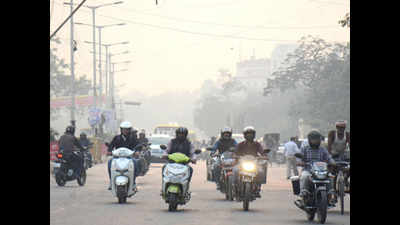- News
- City News
- patna News
- Patna’s air 3rd most polluted in country
Trending
This story is from November 22, 2018
Patna’s air 3rd most polluted in country

A view of traffic under heavy smog in the atmosphere on Bailey road in Patna on Wednesday.
PATNA: Air quality in Patna continued to deteriorate for the third consecutive day on Wednesday. The air quality index (AQI) of the city, as per a bulletin issued by the Central Pollution Control Board (CPCB), surged from 402 on Tuesday to 423 on Wednesday, the third highest in the country.
Muzaffarpur topped the chart in terms of level of air pollution as the AQI of the north Bihar city was measured at 445, followed by Bhiwadi in Rajasthan, where the AQI stood at 444.
As per the guidelines of CPCB, the AQI above 400 is categorized a ‘severe’, which can affect healthy people and seriously impact those with existing diseases.
Delhi, on the other hand, recorded an AQI of 373 on Wednesday, which was in ‘very poor’ category. Gaya in south Bihar too witnessed ‘very poor’ with an AQI of 323.
PM2.5 has been found to be the biggest contributor in the AQI in Patna and Muzaffarpur. The main sources of PM2.5, which can reach the lung and cause damage to the respiratory system, has been found to be road dust, construction activities a vehicular emission.
As per an action plan to tackle air pollution released by the Bihar State Pollution Control Board in May this year, road dust, vehicular emission, domestic fuel burning, open waste burning, construction activities and industrial emissions have been identified as the major source of air pollution in the city.
The average level of PM2.5 in the air in Patna on Wednesday was around 284 micrograms per cubic metre, nearly three times the daily permissible limit of 100 micrograms per cubic metre.
According to environmental advocacy group Centre for Environment and Energy Development (CEED), Patnaites can be exposed to the worst air pollution during nights and early mornings. “It is advisable to avoid strenuous physical activities in the morning and to delay early morning walks,” said Ankita Jyoti, senior programme officer at CEED.
Weather experts attributed meteorological factors, including thermal inversion and high level of humidity, as the reasons behind surge in the AQI. “Atmospheric inversion traps pollutants close to the ground, leading to haze, which is being witnessed lately. Such conditions normally prevail in Patna from mid-November to December,” said Pradhan Parth Sarthi, associate professor at Centre for Environmental Sciences, Central University of South Bihar.
Muzaffarpur topped the chart in terms of level of air pollution as the AQI of the north Bihar city was measured at 445, followed by Bhiwadi in Rajasthan, where the AQI stood at 444.
As per the guidelines of CPCB, the AQI above 400 is categorized a ‘severe’, which can affect healthy people and seriously impact those with existing diseases.
Delhi, on the other hand, recorded an AQI of 373 on Wednesday, which was in ‘very poor’ category. Gaya in south Bihar too witnessed ‘very poor’ with an AQI of 323.
The AQI is an assessment of the air quality taking into account eight pollutants – PM2.5 (particulate matter less than 10 micron), PM10 (particulate matter less than 10 micron), nitrogen oxides, sulphur dioxide, ozone, carbon monoxide, ammonia and lead.
PM2.5 has been found to be the biggest contributor in the AQI in Patna and Muzaffarpur. The main sources of PM2.5, which can reach the lung and cause damage to the respiratory system, has been found to be road dust, construction activities a vehicular emission.
As per an action plan to tackle air pollution released by the Bihar State Pollution Control Board in May this year, road dust, vehicular emission, domestic fuel burning, open waste burning, construction activities and industrial emissions have been identified as the major source of air pollution in the city.
The average level of PM2.5 in the air in Patna on Wednesday was around 284 micrograms per cubic metre, nearly three times the daily permissible limit of 100 micrograms per cubic metre.
According to environmental advocacy group Centre for Environment and Energy Development (CEED), Patnaites can be exposed to the worst air pollution during nights and early mornings. “It is advisable to avoid strenuous physical activities in the morning and to delay early morning walks,” said Ankita Jyoti, senior programme officer at CEED.
Weather experts attributed meteorological factors, including thermal inversion and high level of humidity, as the reasons behind surge in the AQI. “Atmospheric inversion traps pollutants close to the ground, leading to haze, which is being witnessed lately. Such conditions normally prevail in Patna from mid-November to December,” said Pradhan Parth Sarthi, associate professor at Centre for Environmental Sciences, Central University of South Bihar.
End of Article
FOLLOW US ON SOCIAL MEDIA










